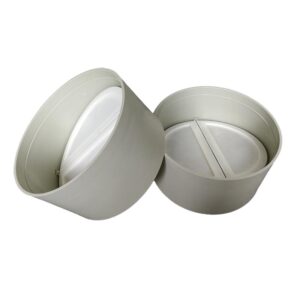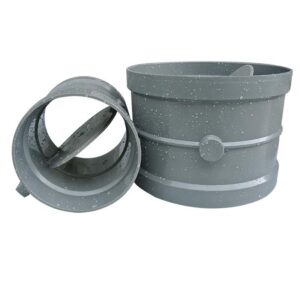Description
A PVC/PP backdraft damper is a type of air flow control device that is designed to allow air to flow in only one direction, while preventing backflow or reverse flow of air.
PVC (polyvinyl chloride) and PP (polypropylene) are two common materials used to manufacture backdraft dampers, as they are lightweight, durable, and resistant to corrosion and moisture. These materials are also non-reactive and do not release harmful chemicals, making them safe for use in air handling systems.

Backdraft dampers are typically installed in ventilation ducts or exhaust systems to prevent the unwanted entry of air, moisture, or contaminants. They work by using flaps or blades that are positioned to allow air to flow in one direction, while closing to prevent reverse flow of air.
Backdraft dampers are commonly used in HVAC (heating, ventilation, and air conditioning) systems, as well as in industrial, commercial, and residential settings. They are an important component for maintaining air quality and preventing the spread of contaminants, and can help to improve energy efficiency and reduce heating and cooling costs.
A backdraft damper is a device used to prevent the backflow of air through a duct or ventilation system. It is typically installed in exhaust fans, dryer vents, and other ventilation systems to prevent air from flowing back into the system when it is not in use.

Here are some general steps for using a backdraft damper:
Install the backdraft damper: The first step is to install the backdraft damper in your ventilation system. The installation process will vary depending on the type of damper you have and the specific system you are installing it in. Follow the manufacturer’s instructions carefully to ensure proper installation.
Test the damper: Once the damper is installed, you can test it by turning on your ventilation system and observing the damper. It should open to allow air to flow out of the system, and then close to prevent air from flowing back in.
Maintain the damper: Backdraft dampers should be inspected regularly to ensure that they are functioning properly. Clean the damper and surrounding area as needed to prevent buildup of dirt or debris that could interfere with its operation.
Replace the damper if necessary: Backdraft dampers may wear out over time or become damaged, and may need to be replaced. If you notice that your damper is not functioning as it should, it may be time for a replacement.
Overall, a backdraft damper is an important device for ensuring the safe and effective operation of your ventilation system. By following these steps and ensuring that your damper is functioning properly, you can help to prevent the backflow of air and ensure that your system is working efficiently.








